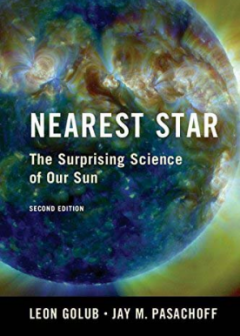Nearest Star: The surprising science of our Sun
| By Leon Golub & Jay M. Pasachoff | Reviewed by Lyn Smith |
| Cambridge University Press, (2nd edn.) 2014 | xvi + 297 pages |
| Price £17.99 (pbk) | ISBN:978-1-107-67264-2 |

The authors of this book are two American astronomers, Leon Golub, a senior astrophysicist at the Harvard-Smithsonian Centre for Astrophysics and Jay M. Pasachoff, a Field Memorial Astronomer at Williams College in Massachusetts. Their goal with this publication is to provide the non-scientific reader with knowledge of solar physics without resorting to explanations involving mathematics and equations. The book is therefore suitable for the amateur astronomer that neglected to pick up a degree in solar physics but who has more than a passing interest in how our Sun works.
The book is divided into eight chapters covering the usual solar features such as sunspots, prominences and flares, but also covers the more intriguing questions of the ‘neutrino problem’ and the science of solar helioseismology. I found the concluding chapters of particular interest, bringing the reader bang up to date with solar-related space missions, space weather and the climate change debate. The authors go into some detail about how to put a mission into orbit and the problems that routinely need to be overcome, and then go on to give a very comprehensive guide to current and near future mission plans. In addition there is a chapter dedicated to eclipse events including an understandable explanation of saros, the precise geometric relationship of the Sun−Moon−Earth system.
If you are expecting a book on practical observing techniques and how to observe the Sun, then you will be disappointed. If however, you want to know a lot more about the structure of our Sun, the solar environment and its impact on the Earth, then you have made the right choice. The book is very readable and explains some complex issues in plain English, which I found to be its main achievement.
I found the book quite difficult to put down once I started it, the pages seeming to turn with alarming frequency until suddenly the Appendices were upon me. The only frustration was that there is still so much we don’t yet know and I so wanted this book to tell me about what hasn’t yet been discovered. That aside, a great read!
Lyn Smith has been observing the Sun since the early 1970s and was appointed Director of the BAA Solar Section in 2006.
| The British Astronomical Association supports amateur astronomers around the UK and the rest of the world. Find out more about the BAA or join us. |
